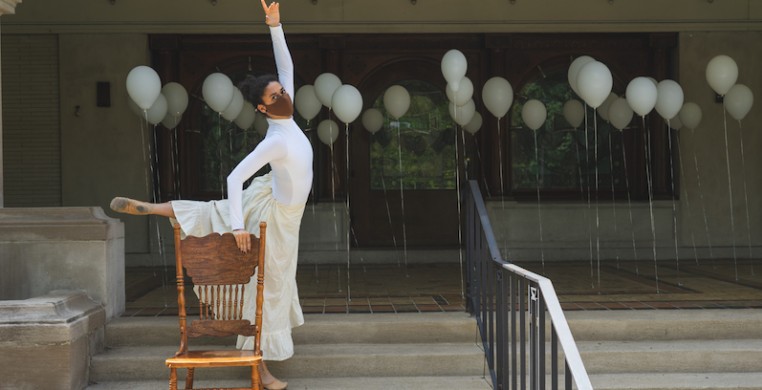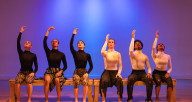I expected my first time as an audience member at a live show since the start of the pandemic would be in a dark, dusty, 60-seat theater with the acrid smell of 40 years’ worth of black paint filling my nostrils while sitting in a chair as old as the building itself, trying not to rattle the loose arm rest or pick at the edges of the frayed, red, crushed velvet upholstery. Instead, I found myself roaming the grassy grounds of a stately mansion, trying not jangle my keys as I walked, the aroma of fresh wildflowers wafting through the air.
On May 16, Winifred Haun & Dancers presented “Finding the Light: Dance at Pleasant Home & Mills Park,” a modern dance program set outside and around Pleasant Home. The large Oak Park mansion was designed by Prairie School architect George W. Maher in 1897 and was made a historic landmark in 1996. The audience was split into two groups, one proceeding after the other as we worked our way around the mansion’s exterior, visiting various parts of the vast yard—more of a public park, really—to view site-specific works, each consisting of only one, two, or three dancers until the full-company finale at the end.
The first of two short solos was “Lady,” choreographed by Mandy Milligan and performed by Jacinda Ratcliffe to a wispy piece of music by Andrew Bird and Sylvan Esso and based on the 1892 painting “Lady Agnew of Locnaw” by portrait artist John Singer Sergent. The only thing tying this work to the painting that I can notice is that there is a lady, a chair and a long and flowy cream-colored dress—her wry smile, the lush blue background and lavish 18th-century French Bergère chair are absent— but Milligan must have seen something I do not in Sergent’s painting as Ratcliffe writhes and falls out of said chair, landing hard on the concrete ground, then ascends large steps onto a small landing filled with white balloons, accumulating them around her left ankle through a series of sweeping arabesque promenades with her leg, slowly gathering a hovering cloud that follows her through the front door of the mansion.
The second solo, “Sight,” has choreographer and guest artist Irene Hsiao trapped and searching for escape from a sunroom, her image obscured by reflections of bouncing green tree branches, making her appear ghostly and ephemeral. Hsiao is accompanied by a medium-toned hand drum and guttural chanting produced by musician Barry Bennett, whose sound I can only describe as a more uninhibited, post-Genesis Phil Collins—and I mean that in a good way. Hsiao emerges from the room, produces a large, white umbrella, and performs a slow meditation, seeming to move with the wind.
“Break,” an a cappella number choreographed by Summer Smith and set against a tree surrounded by a circular bench, is like a Spring awakening, with dancers Crystal Gurrola, Quint Lattimore and Julia Schaeffer—wearing colors of yellow, purple and plum—being inextricably drawn to the freshly budded tree and bend toward it like flowers growing towards the sunlight. We follow Lattimore and Schaeffer to another chair, this one made of light-gray concrete, for the next piece, again without music, titled “Rekindled Hearts,” choreographed by Vernon Gooden. At first, furtive movements show the couple’s apprehension, but soon coy glances at the audience express their desire until, ultimately, the two lovers embrace.
“Disquiet,” by choreographer Elysia Banks has dancer Natalie Dellutri cutting across an open field with quick, jerky movements and sharp about-faces, though the technique seems muted, perhaps due to a lack of traction by dancing on lumpy grass in sneakers.
“(T)here,” by Ratcliffe and danced by Milligan is also set in a sunroom and resembles “Sight” in concept and execution, but does end with a satisfying twist: instead of breaking out of her cage, Milligan rejects the outside and instead recedes back into the safety of her prison, closing the door behind her.
Just across the walkway we find dancers Gooden and Smith standing apart between a tall, ashy sycamore tree and a black, winding bicycle rack shaped like a rounded double-UUs. Both tree and rack serve as backdrop and props for Gurrola’s “Weeping Roots.” Smith is swayed to come over to the curling bike rack and the two thread through it like needles through a cloth, with Smith compressing herself down to fit through the rack’s tight loops while Gooden performs flying split leaps, using the rack’s peaks as sawhorses, directly over Smith’s head and ends breathtakingly with Gooden launching Smith up the trunk of the sycamore for a series of gravity-defying leaps.
Before the finale is “Still Moving,” legitimately creepy, as designer and dancer Lattimore crawls like a gargoyle come-to-life along the wall and slips down into the large bushes and emerges as a fierce jungle cat eyeing the audience as if they are delicious prey.
The evening concludes with “Spring in the Garden,” a premiere by Winifred Haun featuring the entire cast performing to a droning accompaniment, again by Bennett. The piece appears to draw from pagan solstice rituals, Swedish midsummer celebrations. Simple, rhythmical canons boomerang the dancers around each other in small groups before they wind up in a seated circle on the ground, arms swirling in elliptical arches while they worship one of their own, a pagan idol promenading in the center. Until now, the dancers and their movements have been relatively reserved, which is why it is exciting when the ensemble explodes into chaos, with bodies and limbs flying this way and that. Here, Haun once again showcases her ability to manage a slow burn that develops into a satisfying, brilliant conclusion.


